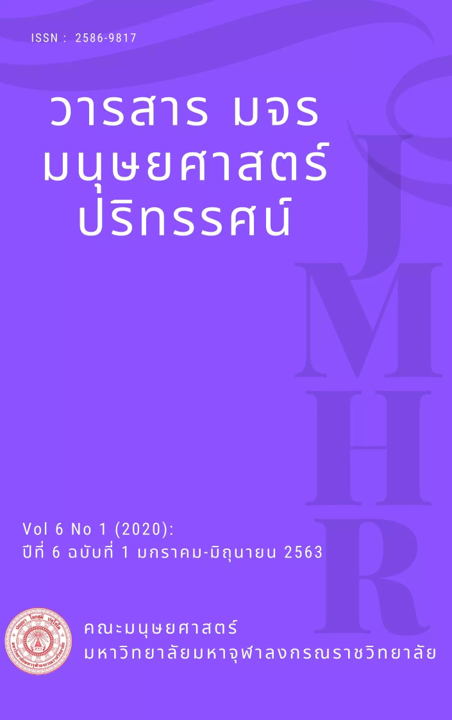วรรณกรรมตำนานพระธาตุจังหวัดพะเยาในฐานะเป็นแหล่งข้อมูลปฐมภูมิ ในการสร้างนวัตกรรมนิทานในจังหวัดพะเยา
คำสำคัญ:
ตำนานพระธาตุจังหวัดพะเยา, กลวิธีการสร้างวรรณกรรมตำนาน, นวัตกรรมนิทานบทคัดย่อ
บทความนี้มีวัตถุประสงค์เพื่อนำเสนอการวิเคราะห์ รูปแบบ โครงสร้าง จารีตนิยมและกลวิธีการสร้างวรรณกรรมตำนานพระธาตุในจังหวัดพะเยาจากเอกสารลายลักษณ์วรรณกรรมตำนานพระธาตุในจังวัดพะเยาจำนวน 19 เรื่อง ที่ปริวรรตและพิมพ์เผยแพร่และตำนานที่เรียบเรียงขึ้นใหม่ในฐานะเป็นข้อมูลปฐมภูมิในการนำมาสร้างนวัตกรรมนิทานเล่าขานประวัติพระธาตุเจดีย์ในจังหวัดพะเยา ผลการวิเคราะห์พบว่า รูปแบบวรรณกรรมพระธาตุประพันธ์ด้วยร้อยแก้ว มีภาษาบาลีประกอบด้วย ภาษาที่ใช้ในการเขียนบรรยายประกอบด้วยภาษาร้อยแก้วล้านนาโบราณ และภาษาร้อยแก้วความเรียงสมัยใหม่ มีโครงสร้าง 3 ตอน คือ 1) เนื้อหากล่าวย้อนหลังกลับไปสมัยพระพุทธเจ้ายังทรงพระชนม์อยู่ หรือเป็นเนื้อหาเป็นปรัมปราคติ 2) เนื้อหากล่าวเหตุการณ์ภายหลังพระพุทธเจ้าทรงปรินิพพานแล้ว โดยมีการอ้างอิงบุคคลคือพระเจ้าอโศกมหาราช และ 3) เนื้อหากล่าวถึงเหตุการณ์ที่เชื่อมโยงถึงเวลาปัจจุบัน ด้านกลวิธีการสร้างพบว่าตำนานพระธาตุพะเยา มีลักษณะจารีตหลักในการสร้างประกอบด้วย 1) ปณามพจน์และบันทึกส่งท้าย 2) จารีตนิยมคำไหว้หรือคำนมัสการแสดงความเคารพนอบน้อม 3) จารีตนิยมอนุภาค คือส่วนย่อยเล็กที่สุดของเรื่องมีความพิเศษและสำคัญ อนุภาคที่เด่นที่สุดในวรรณกรรมตำนานพระธาตุคือ เรื่องพระบรมสารีริกธาตุเป็นอนุภาคที่ส่งผลให้เกิดการแต่งตำนานมารองรับ การสร้างปูชนียสถานเพื่อบรรจุ ประเพณี พิธีกรรม และความอื่น ๆ ที่เกี่ยวข้องกับพระบรมสารีริกธาตุ
เอกสารอ้างอิง
กระทรวงมหาดไทย, สำนักงานจังหวัดพะเยา. หนังสือประวัติมหาดไทยส่วนภูมิภาคจังหวัดพะเยา. ม.ป.ท.ม.ป.พ.
กรมศิลปากร, สำนักโบราณคดีและพิพิธภัณฑ์สถานแห่งชาติ. (2550). ศัพทานุกรมโบราณคดี. กรุงเทพฯ: กรมศิลปากร.
คณะกรรมการฝ่ายประมวลเอกสารและจดหมายเหตุในคณะกรรการอำนวยการจัดงานเฉลิมพระเกียรติพระบาทสมเด็จพระเจ้าอยู่หัวฯ. (2544). วัฒนธรรม พัฒนาการทางประวัติศาสตร์ เอกลักษณ์และภูมิปัญญาจังหวัดพะเยา. จัดพิมพ์เนื่องในโอกาสพระราชพิธีมหามงคลเฉลิมพระชนมพรรษา 6 รอบ 5 ธันวาคม 2542. กรุงเทพฯ : กระทรวงมหาดไทย : กระทรวงศึกษาธิการ : กรมศิลปากร.
ประภัสสร์ ชูวิเชียร. (2554). 5 มหาเจดีย์สยาม. กรุงเทพฯ : มิวเซียมเพรส.
พระคัมภีร์ถูปวงศ์ ตำนานว่าด้วยการสร้างพระสถูปเจดีย์. (2511). พิมพ์เรื่องในงานพระราชทานเพลิงศพนางอนุ ทองไข่มุกด์.
พระธรรมวิมลโมลี. (2550). อัครดุษฎีบัณฑิตแห่งภูกามยาว. พะเยา: วัดศรีโคมคำ ตำบลเวียง อำเภอเมือง จังหวัดพะเยา.
พระมหาศรีบรรดร ถิรธมโม และคณะ. (2545). พระธาตุสำคัญเมืองพะเยา. โครงการสืบสานวัฒนธรรมภูกามยาวมหาวิทยาลัยมหาจุฬาลงกรณราชวิทยาลัย.
พระศรีวิสุทธิโกศล. ( 2546). การศึกษาเชิงวิเคราะห์มหาปรินิพพานสูตร : ศึกษาเฉพาะกรณีการรักษาหลักพระธรรมวินัย (วิทยานิพนธ์พุทธศาสตรมหาบัณฑิต, สาขาวิชาพระพุทธศาสนา. บัณฑิตวิทยาลัย). มหาวิทยาลัยมหาจุฬาลงกรณราชวิทยาลัย. กรุงเทพฯ.
บำเพ็ญ ระวิน,และอุดม รุ่งเรืองศรี, (2530). รายงานการวิจัยศัพท์หมวดภาษาบาลีขอมล้านนา และศัพท์ขอมในภาษาล้านนา.ภาควิชาภาษาไทย, มหาวิทยาลัยเชียงใหม่.
พระมหาสามีธรรมรส. (2553). พุทธตำนานพระเจ้าเลียบโลก. ปริวรรตโดย สิงฆะ วรรณสัย.โครงการหนังสือธรรมะธรรมทาน คณะบริหารธุรกิจ มหาวิทยาลัยเชียงใหม่ พิมพ์เป็นธรรมบรรณาการ เนื่องในงานพิธีกฐินพระราชทาน ณ วัดพระธาตุหริภุญชัย วรมหาวิหาร ลำพูน วันอาทิตย์ที่ 31 ตุลาคม พ.ศ. 2553.
รัญจวน อินทรกำแหง. (2524). การอ่านและการพิจารณาหนังสือ. (พิมพ์ครั้งที่ 5), กรุงเทพฯ: อักษรเจริญทัศน์.
สถาบันวิจัยสังคม. มหาวิทยาลัยเชียงใหม่. (2534). รายชื่อหนังสือโบราณล้านนา : เอกสารไมโครฟิล์มของสถาบันวิจัยสังคม มหาวิทยาลัยเชียงใหม่ พ.ศ.2521-2533. เชียงใหม่: สถาบันวิจัยสังคม มหาวิทยาลัยเชียงใหม่.
สุจิตต์ วงศ์เทศ. (บ.ก.). (2538). ประวัติศาสตร์ สังคมและวัฒนธรรมเมืองพะเยา. กรุงเทพฯ: มติชน.
สำนักงานพระพุทธศาสนาจังหวัดพะเยา. (2555). วัดในจังหวัดพะเยา. สืบค้น 4 มกราคม 2561, จาก http://pyo.onab.go.th/index.php?option=com_content&view=article&id=184&Itemid=158






